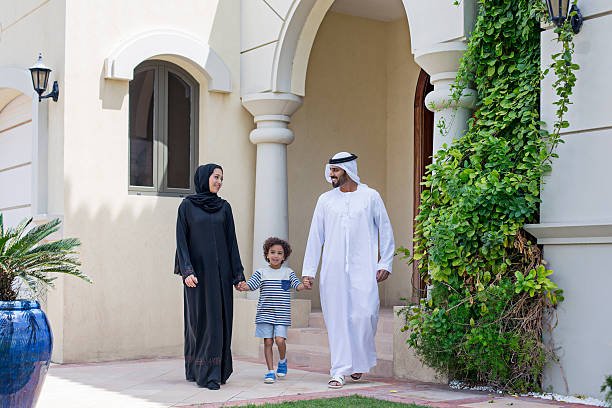The United Arab Emirates (UAE) is known for its rich cultural heritage, and traditional Emirati clothing reflects both Islamic values and the desert environment. While Western fashion has influenced everyday attire in cities like Dubai and Abu Dhabi, many Emiratis still wear their traditional clothing, especially during cultural events, religious ceremonies, and national celebrations.

In this article, we will explore the key elements of Emirati clothing for men and women, their significance, and how modern fashion has adapted these timeless styles.
Traditional Emirati Clothing for Men
1. Kandura (Dishdasha)
The Kandura (also called Dishdasha or Thobé) is a long, white garment worn by Emirati men. It is designed for comfort in the hot desert climate.
- Color: Usually white (to reflect the sun’s heat), but darker shades such as brown or gray are worn in winter.
- Material: Lightweight cotton or breathable synthetic fabrics.
- Accessories:
- Ghutra and Egal – A white or red-checkered headscarf (Ghutra) secured with a black cord (Egal).
- Bisht – A formal cloak worn over the kandura for special occasions, often trimmed with gold or silver embroidery.
2. Sandals (Nal)
Traditional Emirati footwear includes simple leather sandals, designed for practicality in the desert.
Traditional Emirati Clothing for Women
1. Abaya
The Abaya is a long, flowing black garment worn over clothing. Although traditionally simple, modern abayas feature intricate embroidery, Swarovski crystals, and even designer labels.
- Style Variations:
- Open-front abayas – Worn like a coat.
- Closed abayas – Pulled over the head.
- Embellished abayas – Worn for weddings and special occasions.
2. Shayla
The Shayla is a lightweight headscarf that complements the abaya. Unlike the tightly wrapped hijab, it is draped loosely over the shoulders.
3. Kaftans and Jalabiyas
For festive occasions, Emirati women wear beautifully decorated kaftans or jalabiyas—long dresses with elaborate embroidery, beadwork, and luxurious fabrics.
Cultural Significance of Emirati Clothing
Emirati clothing is much more than a practical way to dress. It is deeply rooted in the cultural values of the UAE, including modesty, respect for family, and tradition. The clothing worn by both men and women reflects a connection to the land, climate, and history of the region.
Modesty, in particular, plays a central role in Emirati clothing. Traditional garments are designed to cover the body in a way that aligns with Islamic principles and regional customs. Flowing fabrics and head coverings symbolize respect for both others and oneself.
Why Emirati Clothing Matters
- Cultural identity – Wearing traditional clothing preserves national heritage.
- Religious significance – Modest clothing aligns with Islamic values.
- Climate adaptation – Lightweight fabrics suit the UAE’s hot climate.
Modern Influence on Emirati Fashion
While tradition remains strong, contemporary Emirati fashion blends heritage with global trends:
- Designer Abayas – International brands like Dolce & Gabbana and Gucci now produce high-end abayas.
- Modest Fashion Movement – Emirati women are influencing global modest fashion with stylish yet conservative designs.
- Men’s Fashion Evolution – Some younger Emirati men experiment with colorful kanduras or tailored cuts.
Conclusion
Emirati clothing is a beautiful expression of the country’s culture and history, blending functionality with elegance. From the classic kandura worn by men to the ornate abayas worn by women, these garments reflect the UAE’s respect for tradition, modesty, and pride in its heritage. As modern influences shape fashion trends, Emirati clothing remains a powerful symbol of national identity.
